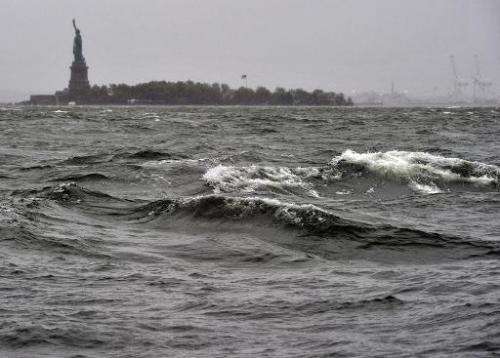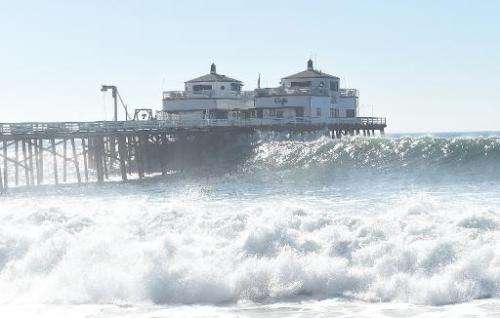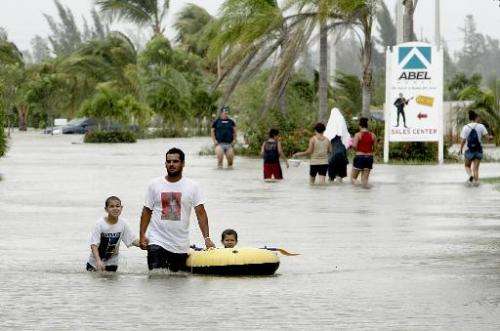US tidal floods will be 'chronic' in 15 yrs, study claims

Many US coastal communities already struggle with flooding at high tides, a problem that will become "chronic" in the coming 15 years due to global warming, scientists said Wednesday.
As shorelines are growing more populated, sea levels are swelling due to melting glaciers and polar ice sheets, putting more populations at risk, said a report by the Union of Concerned Scientists.
Particularly dire consequences are expected along the US east coast and the Gulf Coast, the report warned.
"Our analysis shows that increases in tidal flooding will be substantial and nearly universal," said the report, based on tidal gauges in 52 coastal communities from the northeastern state of Maine down to Florida and along the Gulf Coast of Texas.
"That means the steady creep of sea level rise will force many communities largely unfamiliar with tidal floods today to grapple with chronic flooding in the next 15 to 30 years."
Scientists said the floods, while not catastrophic, could harm key infrastructure such as bridges and roads and cause property damage.
From 1880 to 2009, global sea levels rose about eight inches (20 centimeters). Today, oceans are rising at an even faster rate.
"No longer an intangible global trend, sea level rise has arrived on the doorstep of communities scattered up and down the east coast, delivered by the tides," it added.
"In the next 15 years alone, two-thirds of these communities could see a tripling or more in the number of high-tide floods each year."
Big changes in mid-Atlantic
The biggest changes are expected in the mid-Atlantic, said the report.

The US capital, Washington, DC, and Annapolis, Maryland can expect more than 150 tidal floods per year by 2030.
In southeastern towns like Savannah, Georgia and Lewisetta, Virginia, "extensive flooding is expected to occur with tides alone on a regular basis within one or two decades," said the report.
"By 2045, even more places can expect to see extensive flooding, including Ocean City, Maryland, and Myrtle Beach, South Carolina."
In some places, the changes may be dramatic. For instance, the northeastern town of New London, Connecticut currently experiences tidal floods about twice per year, but that could rise to 35 in 30 years.
Spots along Texas's Gulf Coast that rarely see tidal floods "could face 35 to 70 tidal floods per year by 2045," the report found.
Some places, like Norfolk, Virginia, have put up tide gates to keep floods out of downtown business districts, but that's not an option everywhere.
Miami, the world's seventh richest city, is built on porous limestone and is already losing water wells to incoming saltwater. The city of 417,000 faces more frequent flooding of business and residential areas.
"By 2030, Miami can expect the frequency of tidal flooding to increase nearly eightfold—from about six per year today to more than 45," said the report.
"And by 2045, the city can expect more than 40 times as many floods as today."

New Jersey's coastal resort towns and gambling haven of Atlantic City—which were battered by Superstorm Sandy in 2012—are also forecast to see floods up to 90 times a year by 2030, and 240 annually by 2045.
"Such unrelenting disruption could radically change the South Jersey Shore as a place to live and play," said the report.
'Dangerous' climate change
The problem is not new, and some east coast communities have already seen "a fourfold increase in the annual number of days with tidal flooding since 1970," it found.

Solutions adopted by some coastal communities involve a combination of defending against the rising waters, accommodating them or retreating from them.
The report urged world leaders to take the threats seriously and plan ahead, but also to cut back on burning fossil fuels that lead to global warming.
"Global emissions are rising rapidly, and are on a trajectory to push surface temperatures more than 2 Celsius (3.6 Fahrenheit) above the pre-industrial average—the threshold beyond which scientists say 'dangerous' climate change becomes unavoidable," said the report.
"To stay below this threshold, and slow the rate of sea level rise later this century and beyond, global carbon emissions need to peak and begin to decline by the end of this decade."
© 2014 AFP
















